Introduction to Sqoop and Hive
Sqoop 與 Hive 簡介
Jazz Yao-Tsung Wang
大綱
- PART 1 : 何時該使用哪一種工具呢?
- PART 2 : Sqoop 簡介
- PART 3 : Hive 簡介
PART 1 : 何時該使用哪一種工具呢?
- 巨量資料的三種處理工具
- BIG DATA AT REST
- MapReduce Framework
- BIG DATA IN MOTION
- In-Memory Processing
- Streaming Data Collection / Data Cleaning
- BIG DATA AT REST
- 三種不同的情境需求:
- 運算密集(Computing-Intensive)
- 讀寫密集(Data-Intensive)
- 即時分析(Realtime Analytics)
巨量資料的三種處理工具
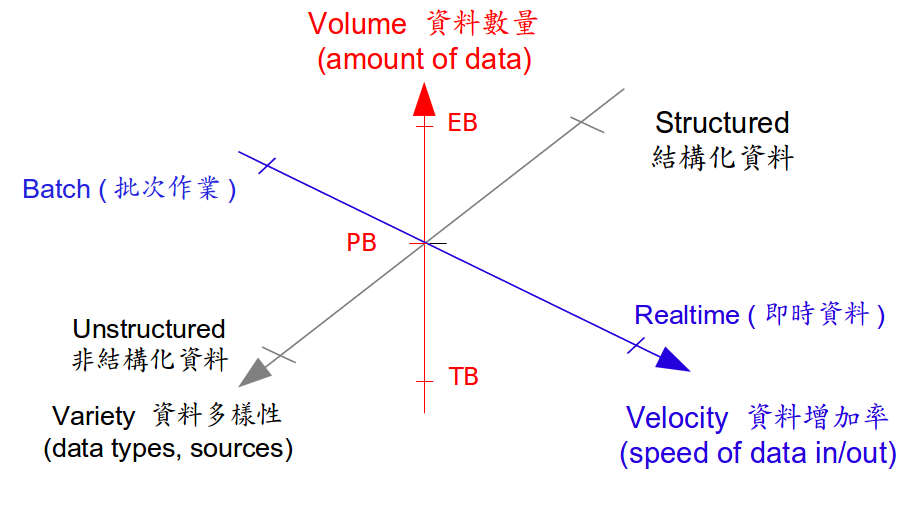
Source : “High Throughput Computing Technologies”, by Jazz Yao-Tsung Wang, September 12, 2013
BIG DATA AT REST

Source : “High Throughput Computing Technologies”, by Jazz Yao-Tsung Wang, September 12, 2013
BIG DATA IN MOTION

Source : “High Throughput Computing Technologies”, by Jazz Yao-Tsung Wang, September 12, 2013
BIG DATA IN MOTION
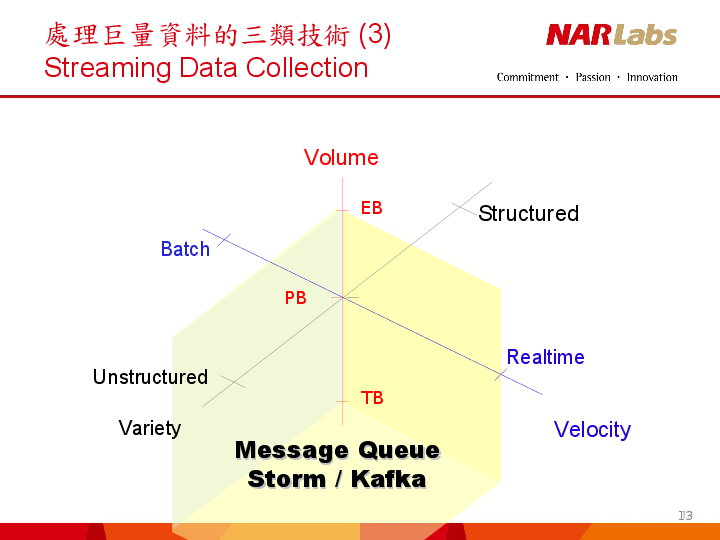
Source : “High Throughput Computing Technologies”, by Jazz Yao-Tsung Wang, September 12, 2013
Apache Big Data Stack (1)
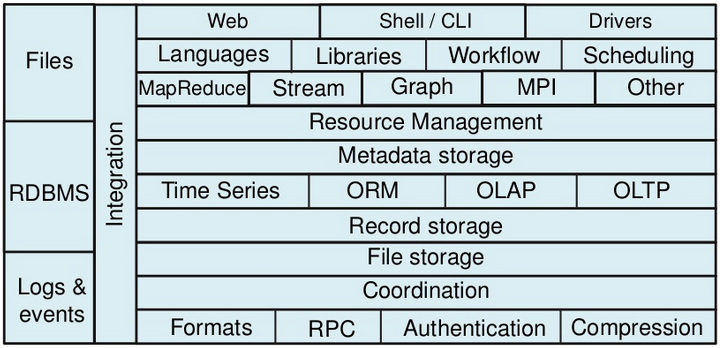
Source : “The Hadoop Stack - Then, Now and in the Future”, Hadoop World 2011
Apache Big Data Stack (2)
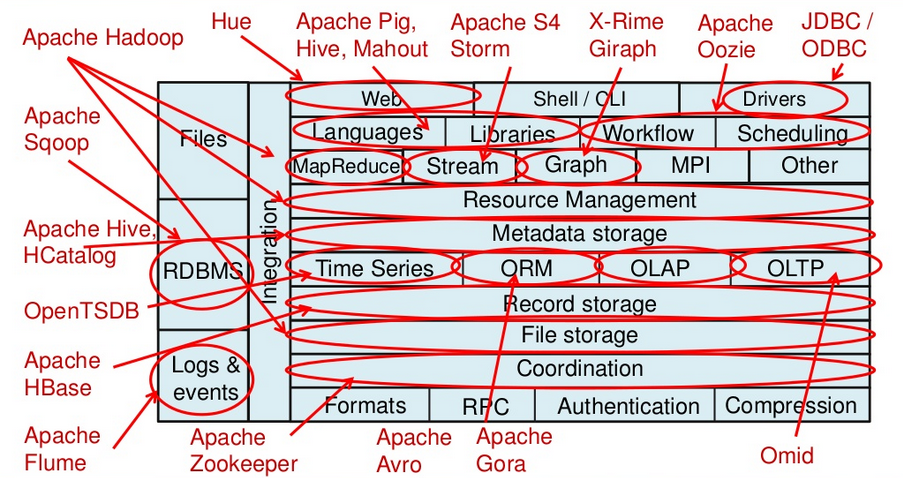
Source : “The Hadoop Stack - Then, Now and in the Future”, Hadoop World 2011
PART 2 : Introduction to Sqoop
- Sqoop = SQL to Hadoop
- Sqoop 允許使用者從關聯式資料庫(RDBMS)中擷取資料到 Hadoop,供後續分析使用。
- Sqoop 也能將分析結果匯入資料庫,供其他用戶端程式使用。
- 專案首頁:http://sqoop.apache.org
- Sqoop 用法:
user@master ~ $ sqoop Try 'sqoop help' for usage.
Sqoop 使用語法
user@master ~ $ sqoop help usage: sqoop COMMAND [ARGS] Available commands: codegen Generate code to interact with database records create-hive-table Import a table definition into Hive eval Evaluate a SQL statement and display the results export Export an HDFS directory to a database table help List available commands import Import a table from a database to HDFS import-all-tables Import tables from a database to HDFS job Work with saved jobs list-databases List available databases on a server list-tables List available tables in a database merge Merge results of incremental imports metastore Run a standalone Sqoop metastore version Display version information See 'sqoop help COMMAND' for information on a specific command.
Sqoop Import (匯入)
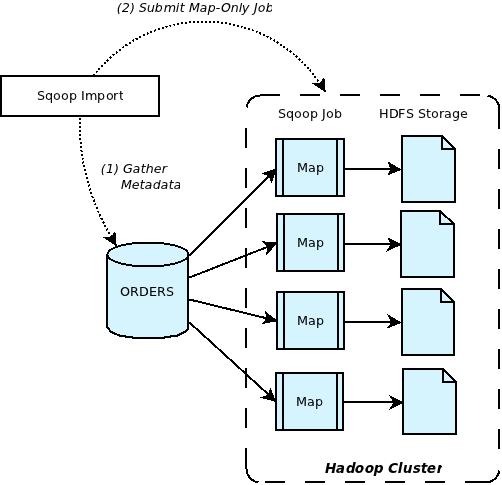
Source : “Apache Sqoop – Overview”, by Arvind Prabhakar, October 06, 2011

Sqoop Import 語法 (1)
user@master ~ $ sqoop help import usage: sqoop import [GENERIC-ARGS] [TOOL-ARGS] Common arguments: --connect [jdbc-uri] Specify JDBC connect string -P Read password from console password --username [username] Set authentication username Import control arguments: --append Imports data in append mode --as-avrodatafile Imports data to Avro data files --as-sequencefile Imports data to SequenceFiles --as-textfile Imports data as plain text (default) --columns [col,col,col...] Columns to import from table -e,--query [statement] Import results of SQL 'statement' -m,--num-mappers [n] Use 'n' map tasks to import in parallel --table [table-name] Table to read --target-dir [dir] HDFS plain table destination --where [where clause] WHERE clause to use during import
Sqoop Import 語法 (2)
Hive arguments: --create-hive-table Fail if the target hive table exists --hive-import Import tables into Hive --hive-table [table-name] Sets the table name to use when importing to hive HBase arguments: --column-family [family] Sets the target column family for the import --hbase-create-table If specified, create missing HBase tables --hbase-row-key [col] Specifies which input column to use as the row key --hbase-table [table] Import to [table] in HBase At minimum, you must specify --connect and --table
Sqoop Export (匯出)
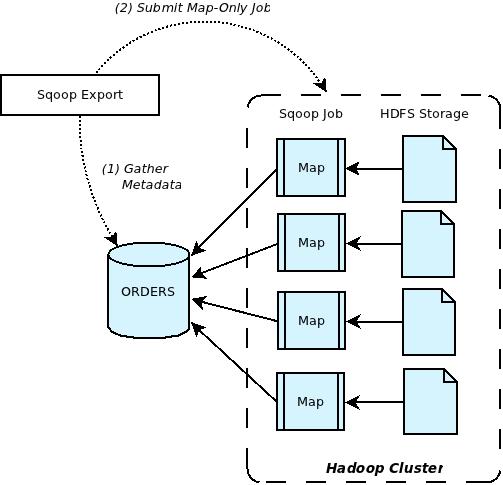
Source : “Apache Sqoop – Overview”, by Arvind Prabhakar, October 06, 2011
Sqoop Export 語法
user@master ~ $ sqoop help export usage: sqoop export [GENERIC-ARGS] [TOOL-ARGS] Common arguments: --connect [jdbc-uri] Specify JDBC connect string -P Read password from console --username [username] Set authentication username Export control arguments: --columns [col,col,col...] Columns to export to table --export-dir [dir] HDFS source path for the export -m,--num-mappers [n] Use 'n' map tasks to export in parallel --table [table-name] Table to populate At minimum, you must specify --connect, --export-dir, and --table
PART 3 : Introduction to Hive
- Jeff Hammerbacher 團隊在臉書(Facebook)打造的資訊平台中,最大構成要素之一
- Hive 是建構於 Hadoop 之上的資料倉儲框架(a framework for data warehousing)。
- Hive 是寫給具備強大 SQL 技能(卻缺乏 Java 程式設計技能)的分析師們,用來查詢臉書存於 HDFS 的海量資料。
- SQL 擁有廣為業界熟知的龐大優勢。是商業智慧(business intelligence)的通用語法(lingua franca,就像 ODBC 是通用橋接器一樣),因此 Hive 能 與這些商品做緊密的整合。
Hive 與傳統資料庫之比較
| 特徵 | Hive | RDBMS |
| Schema | Schema on READ | Schema on WRITE |
| 更新(Update) | 支援 INSERT | 支援 UPDATE, INSERT, DELETE |
| 交易(Transaction) | 不支援 | 支援 |
| 索引(Indexes) | 不支援 | 支援 |
| 延遲(Latency) | 數分鐘 | 秒以內 |
| 函數(Function) | 數十個內建函數 | 上百個內建函數 |
| 多重表格新增 | 支援 | 不支援 |
| SELECT時建立資料表 | 支援 | 在 SQL-02 不支援 |
| SELECT | FROM 子句限用單一資料表 | SQL-92 標準 |
| JOIN | INNER, OUTER, SEMI, MAP JOINS | SQL-92 或其他變形 |
| 次查詢(Subqueries) | 只能在 FROM 子句中使用 | 在任何子句 |
“Schema on Write” vs “Schema on Read”
- 「schema on write」:在傳統資料庫中,一個資料表的 schema 是在資料載入時就被強制套用了。
- 讓查詢的效率比較快
- 可以針對欄位做索引,並對資料做壓縮。
- 代價是它必須花較久的時間來把資料載入資料庫
- 「schema on read」:Hive 並不會在資料載入時進行驗證,相反地它只有在進行查詢時才作驗證。
- 讓初始化載入可以很快執行
- 載入(Load)的操作只是檔案的複製或搬運
- 較有彈性:假設有兩種 schema 對應相同的底層資料,視欲執行之分析而定
- 有許多情境(scenario)是載入 schema 時無法預知的,因此在還沒執行查詢前,無法套用索引。